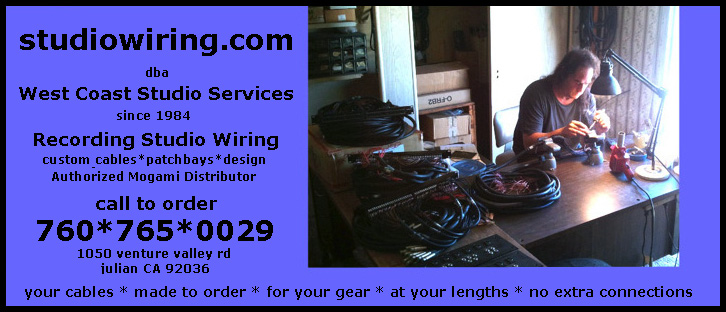
W
West Coast Studio Services, studio wiring, recording studio design, mogami
cable, analog audio systems. . |

![]()
![]() (760) 765-0029
(760) 765-0029 ![]()
![]()
OFFICE HOURS: ANYTIME I'M HERE , BETWEEN 8 A.M- 8 P.M. PST.
. . . some old shop pics . . .
It would be a perfect world if all my clients called me before buying the wires. I understand the difficulty of finding over-the-counter cables sufficient to properly wire your home recording system. I congratulate all of you who have managed to assemble a working system, no matter how innovative it is. The systems I build are point to point patchbays, custom designed for your gear, custom designed to how you work, and prewired for how you intend to expand. The real question is when you decide to switch from the over-the-counter world, to the prefessional systems I provide. Wiring is expensive, and I'm hoping to save clients from paying twice.
The first question to ask yourself is, "Do I need a patchbay?". The answer is simple. If your system is small, and you don't ever change your tracking method, maybe not. Simple home recording systems can be wired with a package of custom cabling, and it's done.
Ok, so your system has grown over the years, and it's time to get the patchbay. The best method sonically is POINT-TO-POINT. I use a switchcraft patchbay, wire it with mogami cable, with switchcraft connectors at the end of the snakes. One wire from bay to gear. The over-the-counter patchbays have a connector in the back. A connection you don't need, or need to pay for. Wiring becomes cheaper, and better sounding without the extra connection in-line. If the studio doesn't move, then point to point is the preferred way to go. I only recommend using an in-line elco multipin connector for highly complex systems, or those that need to move easily.
So the next qustion I always get is, "What are normals, and how do they work?". I do it at the bay, and there is no need to worry about it any longer. I'll ask you the proper questions to make sure all the normalled paths you need are included.
Engineering styles vary greatly, but can be catagorized into two main groups. The more seasoned recording engineers use a console to monitor or mix, while the newer modern recording engineers "mix in the box", basically using two channels of the computer as their stereo mix output. Have i successfully not offended anyone? So those with a console need a full patchbay, wired primarily for the console routing, and those without need a basic system with the A/D's, and supporting analog gear. Whatever you need, I'll design a patchbay for how you work.
It's your studio, your patchbay, your preference..
Please e-mail any questions to: